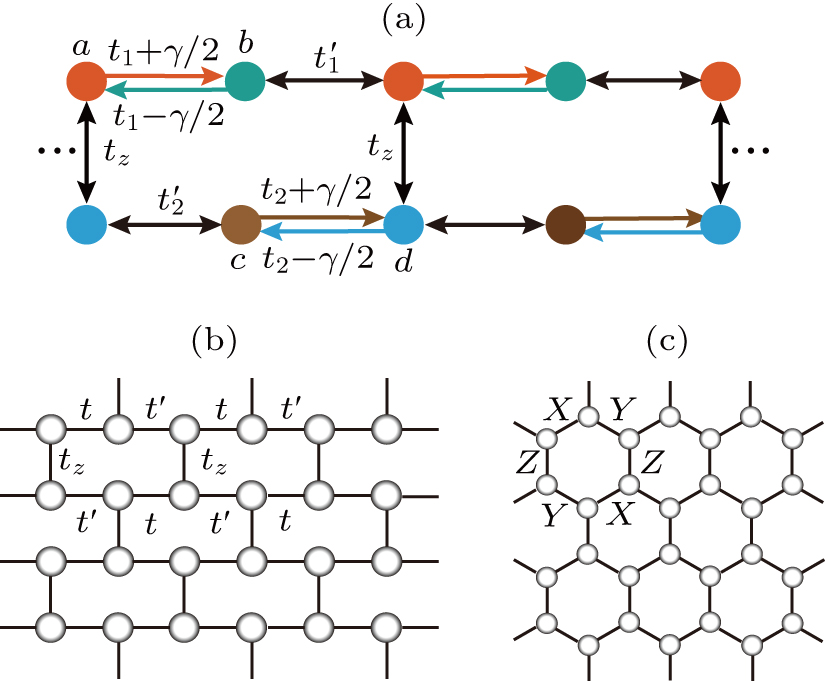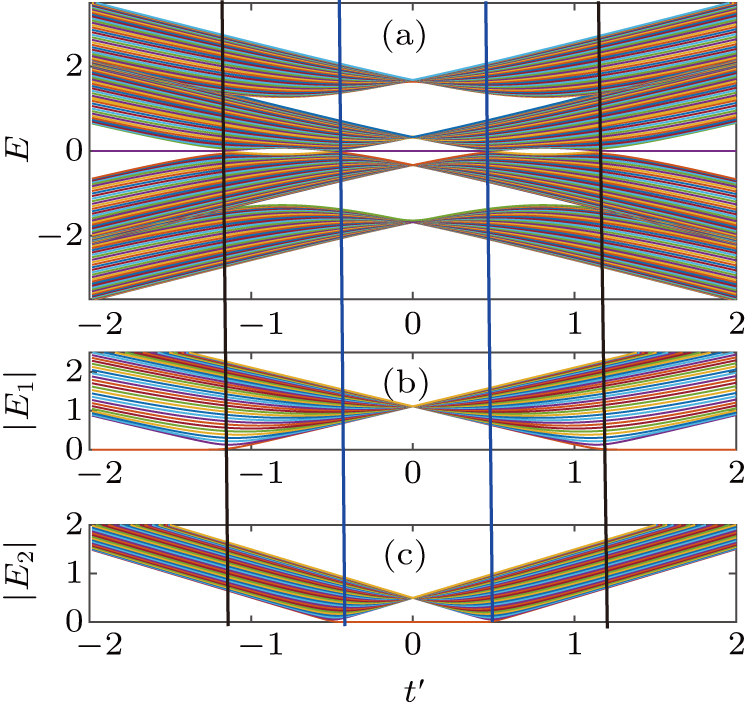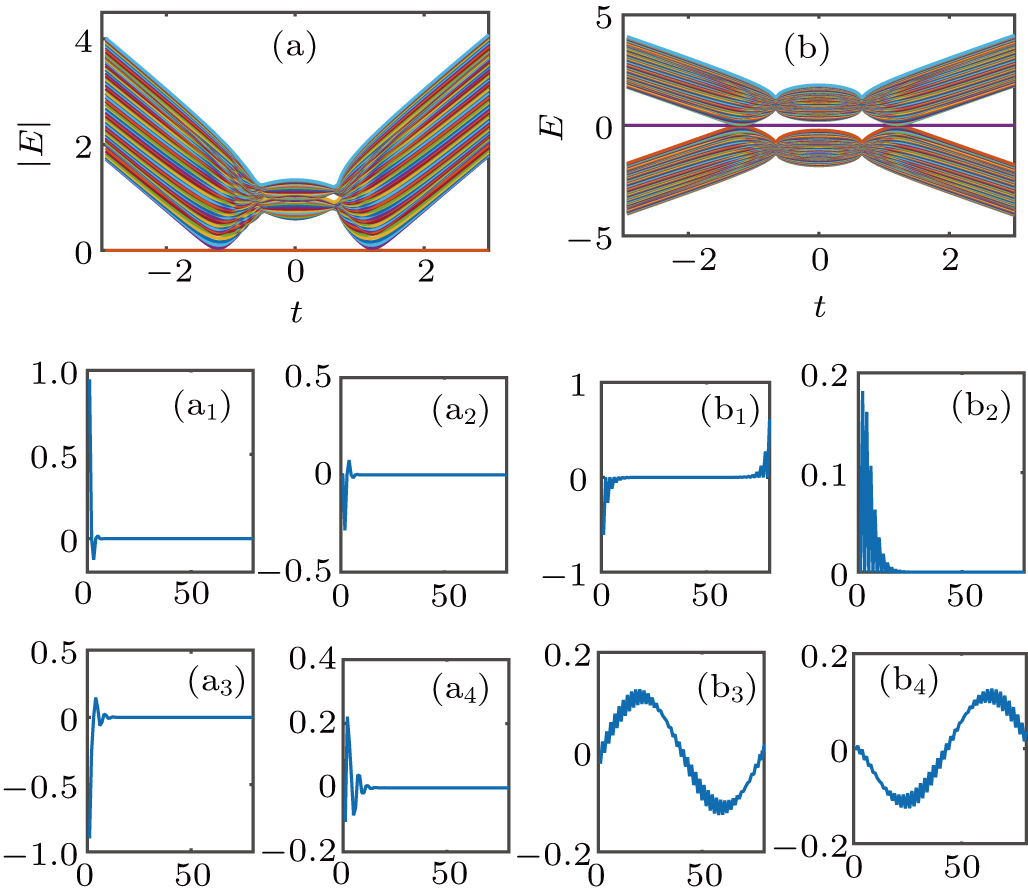† Corresponding author. E-mail:
We study topological phases of a non-Hermitian coupled Su–Schrieffer–Heeger (SSH) ladder. The model originates from the brick-wall lattices in the two-row limit. The Hamiltonian can be brought into block off-diagonal form and the winding number can be defined with the determine of the block off-diagonal matrix. We find the determine of the off-diagonal matrix has nothing to do with the interleg hopping of the ladder. So the topological phases of the model are the same as those of the chains. Further numerical simulations verify the analysis.
A number of recent works have started to explore the topological properties of non-Hermitian systems,[1–31] since non-Hermitian effects are found applicable in a wide range of systems including open boundaries[32–40] and systems with gain and/or loss.[25,41–57] Interestingly, non-Hermitian Hamiltonian exhibits the intriguing features and many other interesting phenomena with no counterpart in Hermitian cases, e.g., the existence of exceptional points where the Hamiltonian becomes nondiagonalizable.[25,58] A key issue of non-Hermitian systems is to find the topological invariants which are responsible for the bulk–boundary correspondence. Previous non-Hermitian topological invariants, including the Chern number, generalized Berry phase, and winding number, are formulated in terms of the Bloch Hamiltonian by employing the biorthonormal eigenvectors.[1–7,9,48] However, numerical results in a one-dimensional (1D) model show that open-boundary spectra look quite different from periodic-boundary ones, which seems to indicate that the bulk topological invariants fail to be responsible for the topological edge states.[2,6]
To establish the non-Hermitian bulk–boundary correspondence, one possible way is to find a Hermitian counterpart of the corresponding non-Hermitian Hamiltonian. The Hermitian Hamiltonian can be constructed with a pseudo-Hermiticity operator. A Hermitian counterpart can have an identical fully real spectrum in the symmetry-unbroken region.[5,59–61] The other case is taking the non-Hermitian skin effect into account, where the bulk states are localized at boundaries and deviate from the extended Bloch waves. The non-Hermitian skin effect is from asymmetric tunneling amplitudes which create effectively an imaginary gauge field. Nonzero imaginary magnetic flux breaks the conventional bulk–boundary correspondence and leads to a topological phase transition.[62,64] A non-Bloch topological invariant is introduced and gives the number of topological edge modes of the non-Hermitian Hamiltonian.[64,64,66,66,67]
The coupled Su–Schrieffer–Heeger (SSH) systems, as the crossover from one-dimensional (1D) to two-dimensional (2D) system, host a rich phase diagram which is different from that of both 1D and 2D systems.[68–70] Then for the non-Hermitian version of the SSH ladder, what is the bulk–boundary correspondence and what is the topological invariant that determines the zero modes? In a study of the model, the winding number was defined in the generalized Brillouin zone (GBZ) and faithfully predicted the topological zero-energy edge modes.[71] We study a special non-Hermitian version of the coupled SSH model which originates from the two-row limit of the brick-wall lattices. Benefiting from the existence of the complex wave vector in GBZ, we can define the winding number in GBZ without solving the model directly. It is found that the winding number has nothing to do with the interleg hopping. The two chains are decoupled completely. We can obtain the topological phase transition point from the studies in Ref. [64]. The numerical analysis is used to verify our study.
The remainder of this paper is organized as follows. In Section
The system is coupled SSH chains with the two-leg ladder structure. The geometry of the system is sketched in Fig.
 | Figure 1. (a) Coupled SSH chains which are the two-row limit of the brick-wall lattice. (b) The brick-wall lattice is equivalent to (c) the honeycomb lattice. |
The model is described by the Hamiltonian
 |





The non-Hermiticity of the Hamiltonian 






 |




The non-Hermitian skin effect determines drastically the topology of the non-Hermitian systems. The non-Bloch bulk–boundary correspondence and generalized Brillouin zone were suggested in the discussion in Ref. [64],[66],[71], and [72]. In the generalized Brillouin zone, the wave number k becomes complex. The real part of the wave vector is from the the periodicity of the system according to the Bloch theorem. The non-Hermitian skin effect attributes to the imaginary part of the complex-valued wave vector. The non-Hermitian topological invariant can be constructed by replacing the Bloch phase factor 








The existence of β gives an opportunity to find the non-Bloch topological invariants of the model according to the results given in Ref. [64] without solving the model directly. With the unitary
 |

 |
 |


 |

When 
From Eq. (















To further understand the model and the non-Hermitian skin effect, we carry out the following similarity transformation 





 |




The open-boundary spectra of Hamiltonian 








The wave functions are shown in Fig.
We have studied topological phases of a special non-Hermitian coupled SSH ladder where the interlegs of the special ladder are cancelled alternately. The model is different from the general ladder and originates from the brick-wall lattices in the two-row limit. With a unity transition, the Hamiltonian in GBZ is brought into block off-diagonal form. According to the calculations of the winding number defined by the determine of the block off-diagonal matrix, we find that the interleg hopping has nothing to do with the topological number of the ladder. So the special coupled SSH chain is decoupled when discussing the topological behavior. The topological properties of the model are determined by the single non-Hermitian SSH chain. This method may be useful to investigate other multi-leg ladder models.
| [1] | |
| [2] | |
| [3] | |
| [4] | |
| [5] | |
| [6] | |
| [7] | |
| [8] | |
| [9] | |
| [10] | |
| [11] | |
| [12] | |
| [13] | |
| [14] | |
| [15] | |
| [16] | |
| [17] | |
| [18] | |
| [19] | |
| [20] | |
| [21] | |
| [22] | |
| [23] | |
| [24] | |
| [25] | |
| [26] | |
| [27] | |
| [28] | |
| [29] | |
| [30] | |
| [31] | |
| [32] | |
| [33] | |
| [34] | |
| [35] | |
| [36] | |
| [37] | |
| [38] | |
| [39] | |
| [40] | |
| [41] | |
| [42] | |
| [43] | |
| [44] | |
| [45] | |
| [46] | |
| [47] | |
| [48] | |
| [49] | |
| [50] | |
| [51] | |
| [52] | |
| [53] | |
| [54] | |
| [55] | |
| [56] | |
| [57] | |
| [58] | |
| [59] | |
| [60] | |
| [61] | |
| [62] | |
| [63] | |
| [64] | |
| [65] | |
| [66] | |
| [67] | |
| [68] | |
| [69] | |
| [70] | |
| [71] | |
| [72] | |
| [73] |















